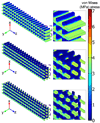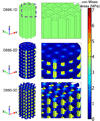Mechanical and microstructural properties of polycaprolactone scaffolds with one-dimensional, two-dimensional, and three-dimensional orthogonally oriented porous architectures produced by selective laser sintering
- PMID: 20144914
- PMCID: PMC2874084
- DOI: 10.1016/j.actbio.2010.02.002
Mechanical and microstructural properties of polycaprolactone scaffolds with one-dimensional, two-dimensional, and three-dimensional orthogonally oriented porous architectures produced by selective laser sintering
Abstract
This article reports on the experimental determination and finite element modeling of tensile and compressive mechanical properties of solid polycaprolactone (PCL) and of porous PCL scaffolds with one-dimensional, two-dimensional and three-dimensional orthogonal, periodic porous architectures produced by selective laser sintering (SLS). PCL scaffolds were built using optimum processing parameters, ensuring scaffolds with nearly full density (>95%) in the designed solid regions and with excellent geometric and dimensional control (within 3-8% of design). The tensile strength of bulk PCL ranged from 10.5 to 16.1 MPa, its modulus ranged from 343.9 to 364.3 MPa, and the tensile yield strength ranged from 8.2 to 10.1 MPa. These values are consistent with reported literature values for PCL processed through various manufacturing methods. Across porosity ranged from 56.87% to 83.3%, the tensile strength ranged from 4.5 to 1.1 MPa, the tensile modulus ranged from 140.5 to 35.5 MPa, and the yield strength ranged from 3.2 to 0.76 MPa. The compressive strength of bulk PCL was 38.7 MPa, the compressive modulus ranged from 297.8 to 317.1 MPa, and the compressive yield strength ranged from 10.3 to 12.5 MPa. Across porosity ranged from 51.1% to 80.9%, the compressive strength ranged from 10.0 to 0.6 MPa, the compressive modulus ranged from 14.9 to 12.1 MPa, and the compressive yield strength ranged from 4.25 to 0.42 MPa. These values, while being in the lower range of reported values for trabecular bone, are the highest reported for PCL scaffolds produced by SLS and are among the highest reported for similar PCL scaffolds produced through other layered manufacturing techniques. Finite element analysis showed good agreement between experimental and computed effective tensile and compressive moduli. Thus, the construction of bone tissue engineering scaffolds endowed with oriented porous architectures and with predictable mechanical properties through SLS is demonstrated.
Copyright 2010 Acta Materialia Inc. Published by Elsevier Ltd. All rights reserved.
Figures







Similar articles
-
Micromechanical finite-element modeling and experimental characterization of the compressive mechanical properties of polycaprolactone-hydroxyapatite composite scaffolds prepared by selective laser sintering for bone tissue engineering.Acta Biomater. 2012 Aug;8(8):3138-43. doi: 10.1016/j.actbio.2012.04.022. Epub 2012 Apr 19. Acta Biomater. 2012. PMID: 22522129 Free PMC article.
-
Bone tissue engineering using polycaprolactone scaffolds fabricated via selective laser sintering.Biomaterials. 2005 Aug;26(23):4817-27. doi: 10.1016/j.biomaterials.2004.11.057. Epub 2005 Jan 23. Biomaterials. 2005. PMID: 15763261
-
Mechanical study of polycaprolactone-hydroxyapatite porous scaffolds created by porogen-based solid freeform fabrication method.J Appl Biomater Funct Mater. 2014 Dec 30;12(3):145-54. doi: 10.5301/JABFM.5000163. J Appl Biomater Funct Mater. 2014. PMID: 24425377
-
Osteogenesis of adipose-derived stem cells on polycaprolactone-β-tricalcium phosphate scaffold fabricated via selective laser sintering and surface coating with collagen type I.J Tissue Eng Regen Med. 2016 Oct;10(10):E337-E353. doi: 10.1002/term.1811. Epub 2013 Aug 16. J Tissue Eng Regen Med. 2016. PMID: 23955935
-
Selective laser sintering in biomedical engineering.Med Biol Eng Comput. 2013 Mar;51(3):245-56. doi: 10.1007/s11517-012-1001-x. Epub 2012 Dec 19. Med Biol Eng Comput. 2013. PMID: 23250790 Review.
Cited by
-
Computational design and evaluation of the mechanical and electrical behavior of a piezoelectric scaffold: a preclinical study.Front Bioeng Biotechnol. 2024 Jan 11;11:1261108. doi: 10.3389/fbioe.2023.1261108. eCollection 2023. Front Bioeng Biotechnol. 2024. PMID: 38274011 Free PMC article.
-
Three-dimensional printing of polycaprolactone/hydroxyapatite bone tissue engineering scaffolds mechanical properties and biological behavior.J Mater Sci Mater Med. 2022 Mar 10;33(3):31. doi: 10.1007/s10856-022-06653-8. J Mater Sci Mater Med. 2022. PMID: 35267105 Free PMC article.
-
Scalable Fabrication of Porous Microchannel Nerve Guidance Scaffolds with Complex Geometries.Adv Mater. 2019 Jul;31(30):e1902021. doi: 10.1002/adma.201902021. Epub 2019 Jun 6. Adv Mater. 2019. PMID: 31168865 Free PMC article.
-
Scaffold translation: barriers between concept and clinic.Tissue Eng Part B Rev. 2011 Dec;17(6):459-74. doi: 10.1089/ten.TEB.2011.0251. Epub 2011 Sep 21. Tissue Eng Part B Rev. 2011. PMID: 21902613 Free PMC article. Review.
-
Open-source three-dimensional printing of biodegradable polymer scaffolds for tissue engineering.J Biomed Mater Res A. 2014 Dec;102(12):4326-35. doi: 10.1002/jbm.a.35108. J Biomed Mater Res A. 2014. PMID: 25493313 Free PMC article.
References
-
- Einhorn TA. Clinical Applications of Recombinant Human BMPs: Early Experience and Future Development. J Bone Joint Surg Am. 2003;85 suppl_3:82–88. - PubMed
-
- Langer R. Tissue Engineering. Molecular Therapy. 2000;1(1):12–15. - PubMed
-
- Greenwald AS, et al. Bone-Graft Substitutes: Facts, Fictions, and Applications. J Bone Joint Surg Am. 2001;83 2_suppl_2:S98–S103. - PubMed
-
- Laurencin CT, et al. Tissue Engineering: Orthopedic Applications. Annual Review of Biomedical Engineering. 2003;1(1):19–46. - PubMed
-
- Langer R, Vacanti JP. Tissue engineering. Science. 1993;260(5110):920–926. - PubMed
Publication types
MeSH terms
Substances
Grants and funding
LinkOut - more resources
Full Text Sources
Other Literature Sources

